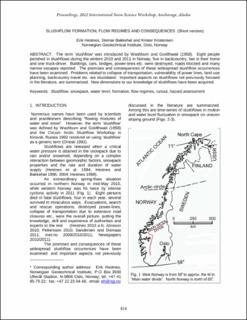| dc.contributor.author | Hestnes, Erik | |
| dc.contributor.author | Bakkehøi, Steinar | |
| dc.contributor.author | Kristensen, Krister | |
| dc.date.accessioned | 2023-08-14T11:06:15Z | |
| dc.date.available | 2023-08-14T11:06:15Z | |
| dc.date.issued | 2012 | |
| dc.identifier.uri | https://hdl.handle.net/11250/3083809 | |
| dc.description.abstract | The term ‘slushflow’ was introduced by Washburn and Goldthwait (1958). Eight people perished in slushflows during the winters 2010 and 2011 in Norway, five in backcountry, two in their home and one truck-driver. Buildings, cars, bridges, power-lines etc. were destroyed, roads blocked and many narrow escapes reported. The premises and consequences of these widespread slushflow occurrences have been examined. Problems related to collapse of transportation, vulnerability of power lines, land-use planning, backcountry travel etc. are elucidated. Important aspects on slushflows not previously focused in the literature, are summarized. New dimensions to our knowledge of slushflows have been acquired. | en_US |
| dc.language.iso | eng | en_US |
| dc.publisher | Montana State University Library | en_US |
| dc.relation.ispartofseries | The International Snow Science Workshop (ISSW) Proceedings; | |
| dc.subject | Slushflow | en_US |
| dc.subject | Snowpack | en_US |
| dc.subject | Water Level | en_US |
| dc.subject | Formation | en_US |
| dc.subject | Flow Regimes | en_US |
| dc.subject | Runout | en_US |
| dc.subject | Hazard Assessment | en_US |
| dc.subject | Avalanche-RnD | en_US |
| dc.subject | Snøskred-FoU | en_US |
| dc.title | Slushflow Formation, Flow Regimes and Consequences (Short Version) | en_US |
| dc.type | Chapter | en_US |
| dc.source.pagenumber | 6 | en_US |
| dc.identifier.doi | https://arc.lib.montana.edu/snow-science/item/1711 | |
